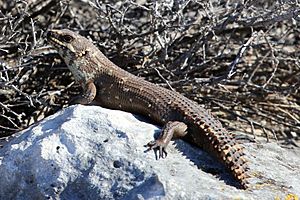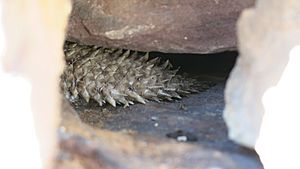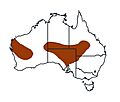Stokes's skink facts for kids
Quick facts for kids Stokes's skink |
|
|---|---|
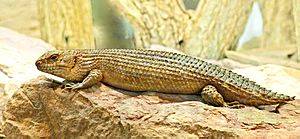 |
|
| Conservation status | |
| Scientific classification | |
| Genus: |
Egernia
|
| Species: |
stokesii
|
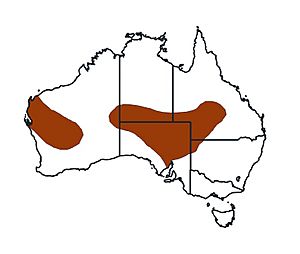 |
|
| Distribution Map of Stokes's skink | |
| Synonyms | |
|
|
The Stokes's skink (Egernia stokesii) is a type of lizard from the skink family. This skink is active during the day (diurnal). It lives only in Australia (endemic). People also call it the Gidgee skink or spiny-tailed skink.
Stokes's skinks live in stable social groups, much like some mammals and birds. This is rare for lizards, but common among Australian skinks in the Egerniinae group. These skinks are found in many places across Australia. They live in dry (semi-arid) areas. There are three types (subspecies) of Stokes's skink. The species is listed as "least concern" for its survival. However, one subspecies is listed as "endangered."
Contents
What Does Stokes's Skink Look Like?
Stokes's skinks can be olive green to reddish-brown. Their belly scales are lighter, from white to yellow. They often have lighter scales scattered on their backs. The scales on their backs and tails are ridged (keeled). Their spiny tail scales are a key feature.
The tail is flat, not round, and shorter than the skink's head and body. It is about 35% of their body length. Stokes's skinks cannot drop their tails if they are in danger. Adult skinks are about 155 to 190 mm long from snout to vent. These skinks grow up slowly. They usually become adults between five and six years old. They can live for 10 to 25 years.
How Do Stokes's Skinks Live?
Stokes's skinks have a complex social life. They form groups of up to 17 related individuals. Living in groups might help them spot predators and control their body temperature. These groups stay together for a long time. Some adults have stayed in the same group for over five years. Young skinks usually stay with their birth group until they are grown.
A typical group includes a breeding pair, their young from different years, and other close relatives. Each group has its own home area. They share several favorite rock or log hiding spots. They also share a common waste pile outside these spots. Skinks can tell who belongs to their group by smell. Different groups might share hiding spots on the edges of their home areas. Skinks in a group often rest in the sun very close to each other. Their sunning spots are always near their hiding places.
What Do Stokes's Skinks Eat?
Stokes's skinks eat both plants and insects (omnivores). Their diet includes arthropods like beetles and grasshoppers. They also eat plant material. Scientists have found seeds from native plants like ruby saltbush in their waste. They also eat seeds from introduced plants like common pigweed.
What they eat can change with the seasons and as they grow. Young skinks eat more insects than plants. Adult skinks eat more plants than insects. This plant eating increases in late summer. Scientists are not sure why their diet changes. It might be due to competition with young skinks or what food is available.
Who Are Their Predators?
Animals that might hunt Stokes's skinks include cats, foxes, and dingos. Other reptiles like the eastern brown snake and monitor lizards also hunt them. Birds of prey can also be a threat.
Stokes's skinks have two main ways to protect themselves. Their spiny tail makes them hard to eat. They also stay close to rock crevices for quick hiding.
Where Do Stokes's Skinks Live?
Stokes's skinks can live on rocky outcrops (saxicolous). They can also live partly in trees (semi-arboreal). They are found in grasslands, woodlands, or shrublands. They are active during the day and do not dig burrows. Instead, they hide in rock crevices, under logs, or in tree hollows. You can find E. stokesii in New South Wales, the Northern Territory, Queensland, South Australia, and Western Australia.
Life Cycle and Reproduction
Stokes's skinks are very monogamous, meaning they usually have one mate for life. They tend to choose mates that are not closely related to them. E. stokesii give birth to live young (viviparous). They have between 1 and 8 babies in each litter. Giving birth can take from one to twelve days. On average, it takes about 2.8 days. Larger females tend to have more babies.
The babies are born head first. They are inside a membrane with a yolk sac. The mother or the newborn skinks might eat these after birth. Newborn skinks are about 65-95mm long. They weigh about 8.15g. In eastern Australia, skinks usually give birth every year in February or March. However, they might not have a litter every single year. A winter birth has been seen in Western Australia. Young skinks are more likely to die in their first year. Adult skinks have a low death rate.
How Stokes's Skinks Are Related to Other Animals
Stokes's skinks are part of the Scincidae family. They belong to a group called Egerniinae. This group includes 8 different types (genera) of skinks. These include Egernia, Tiliqua (blue-tongued skinks), and Cyclodomorphus. There are 61 living species in this group. They are found in Australia, New Guinea, and the Solomon Islands.
Scientists believe the Egerniinae group started to develop in Australia about 35 million years ago. This was likely due to climate changes between ice ages and dry periods.
What Do Their Names Mean?
The name stokesii honors Royal Navy Admiral John Lort Stokes.
The subspecies name zellingi honors British collector Charles Weldon De Burgh Birch, Count Zelling.
Types of Stokes's Skink
There are three types (subspecies) of Egernia stokesii. Each lives in a different area:
- E. stokesii zellingi: Found in dry areas of South Australia, New South Wales, the Northern Territory, and Queensland.
- E. stokesii stokesii: Lives on the islands of the Abrolhos Archipelago off Western Australia.
- E. stokesii badia: Found in the Wheatbelt, Murchison, and Shark Bay areas of Western Australia. This type also includes E. stokesii aethipos, which lives on Baudin Island.
Protecting Stokes's Skink
The International Union for the Conservation of Nature (IUCN) lists Egernia stokesii as "Least Concern." However, the number of skinks is going down. Their populations are broken up into small groups. Their homes are being changed or damaged by farming, mining, and different fire patterns.
The subspecies E. stokesii badia, also called the Western spiny-tailed skink, is listed as "endangered." This means it is at high risk of dying out. The main threats to this subspecies are land clearing, grazing by animals, and farming.
Images for kids
See also
 In Spanish: Egernia stokesii para niños
In Spanish: Egernia stokesii para niños



